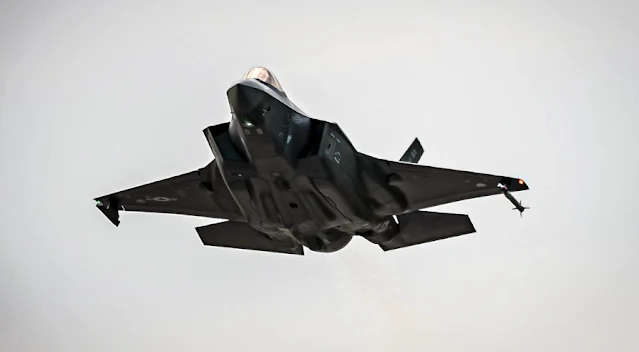 |
| US F-35A Stealth Fighter Still Can't Fly Within 40.2 Km Of Lightning |
International Military - Thanks to a compromised ability to render its fuel tanks inert, the United States' F-35A Lighting II stealth fighter cannot fly within 25 miles (40.2 km) of thunderstorms or other atmospheric electrical activity. This condition has not changed after more than two years of flight restrictions being issued, and these restrictions have not been lifted. This was revealed by Forbes in its report, which was launched on Thursday (24/11/2022).
As one can imagine, the ban on flying near thunderstorms has implications for F-35A training, especially in places like Eglin Air Force Base located in Florida where thunderstorms are frequent. Eglin is home to the Air Force's 58th Fighter Squadron which trains novice F-35A pilots, about 60 pilots per year.
According to the Fobres report, a thunderstorm within 25 nautical miles of the base will halt take-offs and landings -- and even F-35 fighter jet training. "The F-35 Joint Programs Office (JPO) does not comment on any impact to flight operations due to operational security concerns," JPO spokesman Chief Petty Officer Matthew Olay said in an email response.
Forbes said the JPO's policy of not commenting would not be a hindrance to the ability of US adversaries to know how much damage was caused by lightning issues in F-35 training.
In addition, a shrewd adversary can in low tension, low threat situations schedule tactical activity to coincide with bad weather in areas where the F-35As might be expected to fly excessively with their electronic intelligence gathering systems picking up data. This is just one example of the impact that flight restrictions may have on the F-35A.
Surprisingly, those restrictions do not apply to Marine Corps F-35Bs or Navy F-35Cs, a point JPO clarified in its email response. Although the JPO did not provide an explanation as to why this is the case, both Navy and Marine Corps aircraft appear to be experiencing the same problems as the F-35A to a lesser degree.
The problem lies with the F-35's OBIGGS (Onboard Inert Gas Generation) system which pumps nitrogen-enriched air into its fuel tanks to make them inert, preventing the plane from exploding if struck by lightning. Apparently, the pipes and fittings in the F-35's fuel tank (which delivers the nitrogen mixture) stop functioning effectively over time due to vibration and possible changes in temperature and pressure during flight.
In 2020, maintainers at Hill Air Force Base Ogden Logistics Complex in Utah discovered a malfunction in the OBIGGS system during F-35A depot maintenance. Subsequent inspections found that 14 of the 24 F-35As examined contained faulty tubing.
That led to a two-week delay in F-35 deliveries while a determination was made whether the problem lay in faulty production. This turned out not to be the case and the shipment continued but JPO issued flight restrictions. Meanwhile, the Department of Defense and Lockheed Martin reached an agreement on fixing the OBIGGS system.
Darren Sekiguchi, Lockheed Martin's vice president of F-35 production at the time, said the repair involved "strengthening a number of brackets associated with this tube for OBIGGS." The modifications, which Lockheed and the US Air Force will begin implementing in 2021, will allow the canisters inside the fuel tanks to be installed more securely and prevent vibrational movement.
In February, the Air Force Times reported that an upgrade to OBIGGS would allow the F-35A to fly near lightning without restriction in mid-summer. However, the lifting of the flight restrictions did not occur. The JPO declined to explain why, despite the problem being fixed, the no-flying near lightning ban remains in effect.
JPO's reluctance to elaborate is curious, especially since Chief Olay explained to Forbes that, "The F-35B and C variants share some of the same OBIGGS issues as the F-35A, but have been able to reduce operational impact."
It's worth remembering that in July 2021 the Marine Corps disclosed that a pair of its F-35Bs were grounded in Japan with multi-million dollar damage after being struck by lightning during a sortie earlier that month.
How the Navy and Marine Corps will mitigate the operational impact, Olay did not say. It is also unclear how the OBIGGS differ in design and function from the B and C variants of the F-35. A clue may lie in the blog of Parker Aerospace who designed and built the OBIGGS system for the F-35.
The fact that the US Air Force's F-35A cannot operate near lightning may arise from the OBIGG architecture specifically. However, it may also indicate the presence of other issues which may or may not be related to OBIGGS. According to the Breaking Defense report, JPO offered no specific plan or timeline for returning the F-35A to full all-weather status.
The JPO simply stated that, "Lightning [flights near] restrictions will be lifted when all safety issues are satisfactorily resolved or mitigated." The JPO said that all F-35As, likely only US aircraft, will receive the OBIGGS hardware upgrade by 2025.
The software modification, which alerts pilots when the OBIGGS system is degraded, began rolling out in August 2022. Given the hardware upgrade schedule, it seems likely that for at least another few years, the U.S. Air Force F-35A should be scrambled if lightning is nearby.




